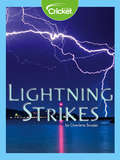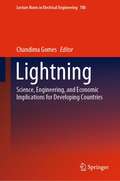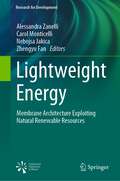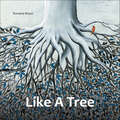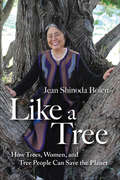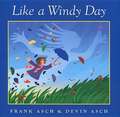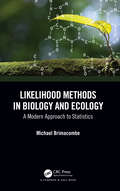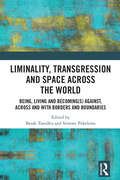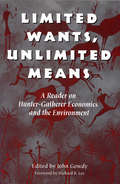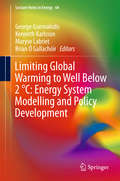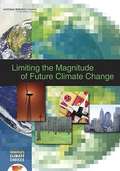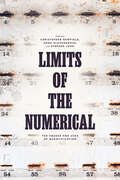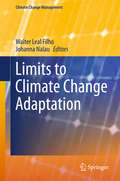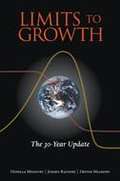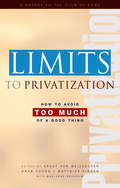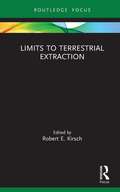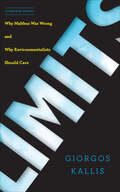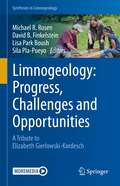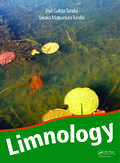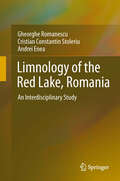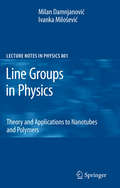- Table View
- List View
Lightning Strikes
by Charlene BrussoHow is lightning created? And what is thunder? What kind of weather creates the most lightning? This science story shows how lightning is like the spark from static electricity, but much bigger.
Lightning: Science, Engineering, and Economic Implications for Developing Countries (Lecture Notes in Electrical Engineering #780)
by Chandima GomesThis book highlights the essential theoretical and practical aspects of lightning, lightning protection, safety and education. Additionally, several auxiliary topics that are required to understand the core themes are also included. The main objective of the contents is to enlighten the scientists, researchers, engineers and social activists (including policy makers) in developing countries regarding the key information related to lightning and thunderstorms. A majority of developing countries are in tropics where the lightning characteristics are somewhat different from those in temperate regions. The housing structures and power/communication networks, and human behavioural patterns(that depends on socio-economic parameters) in these countries are also different from those in the developed world. As the existing books on similar themes address only those scenarios in developed countries, this book serves a vast spectrum of readership in developing world who seek knowledge in the principles of lightning and a practical guidance on lightning protection and safety education.
Lightweight Energy: Membrane Architecture Exploiting Natural Renewable Resources (Research for Development)
by Alessandra Zanelli Carol Monticelli Nebojsa Jakica Zhengyu FanThis book explores membrane materials as a means of translating natural and renewable resources into a more flexible, dynamic, and reactive architectural skin. It represents the first time that energy-saving design has been addressed systematically in relation to lightweight building systems and tensile membranes. Understanding of the energetic behavior of membranes and foils used as a building envelope is a fundamental theme, as it is the integration of flexible photovoltaics in membranes, as well as the exploitation of water and wind resources. A theoretical, methodological framework for consciously designing the membrane life cycle is presented. The authors cross-cut and combine exploration of climate-based design methodology and life cycle thinking strategies. Both active and passive systems are investigated, referring to alternative productive resources like sun, wind, and water. Case studies are brought forward in the book’s second half, highlighting energy lightness for an increasingly dematerialized architecture and addressing inherent issues. Four main research and development paths are presented, the first two focusing on advancements in façade materials and Photovoltaic systems applicable to membrane architecture, the third referring to fog and dew harvesting and the fourth dealing with the future frontier of flexible transparency and designs for well-being through a passive solar system.
Like a Tree
by Rossana BossùAn engaging internationally award-winning title that captures the beauty of life and symmetries in nature in a mixture of poetry and science for young readers. Poetic language and science come together for a truly remarkable look at what makes us all alive. Beautiful illustrations feature simple verbs, leading into lyrical text that shows the life cycles of various living things in nature, comparing the actions of human life to a tree. From the trees to the birds to a single tiny snowflake, we all live together, dance together, and breathe together to create a symphony of life. Clear facts and vivid imagery give the reader enough to use their imagination to look at nature and look at themselves with wonder and to discover how everything is connected.
Like a Tree: How Trees, Women, and Tree People Can Save the Planet
by Jean Shinoda BolenThe internationally known author and speaker provides an insightful look into the fusion of ecological issues and global gender politics.This book on the importance of trees grew out of Bolen’s experience mourning the loss of a Monterey pine that was cut down in her neighborhood. That, combined with her practice of walking among tall trees, led to her deep connection with trees and an understanding of their many complexities. She expertly explores the dynamics of ecological activism, spiritual activism, and sacred feminism. And, she invites us to join the movement to save trees.While there is still much work to be done to address environmental problems, there are many stories of individuals and organizations rising up to make a change and help save our planet. The words and stories that Bolen weaves throughout this book are both inspirational and down-to-earth, calling us to realize what is happening to not only our trees, but our people.In Like a Tree learn more about: The dynamic nature of trees — from their anatomy to their role as an archetypal symbol Pressing social issues such as deforestation, global warming, and overpopulation What it means to be a “tree person”“You will never again see [a tree] without knowing it has a novel inside, it’s supporting your life, and it’s more spiritual than any church, temple or mosque. Like a Tree is the rare book that not only informs, but offers a larger consciousness of life itself.” —Gloria Steinem
Like a Windy Day
by Frank AschThe wind is powerful and stormy, mischievous and unpredictable. In this magical story, a young girl goes soaring, tumbling, and twirling on her own exciting windy-day adventure.
Likelihood Methods in Biology and Ecology: A Modern Approach to Statistics
by Michael BrimacombeThis book emphasizes the importance of the likelihood function in statistical theory and applications and discusses it in the context of biology and ecology. Bayesian and frequentist methods both use the likelihood function and provide differing but related insights. This is examined here both through review of basic methodology and also the integr
Liminality, Transgression and Space Across the World: Being, Living and Becoming(s) Against, Across and with Borders and Boundaries
by Basak Tanulku Simone PekelsmaThis book analyses various forms of liminality and transgression in different geographies and demonstrates how and why various physical and symbolic boundaries create liminality and transgression.Its focus is on comprehending the ways in which these borders and boundaries generate liminality and transgression rather than viewing them solely as issues. It provides case studies from the past and present, allowing readers to connect subjects, periods, and geographies. It consists of theoretical and empirical chapters that demonstrate how borders and liminality are interconnected. The book also benefits from the power of several visual essays by artists to complete the theoretical and empirical chapters which demonstrate different forms of liminality without need of much words.The book will be of interest to researchers and students working in the fields of urban and rural studies, urban sociology, cities and communities, urban and regional planning, urban anthropology, political science, migration studies, human geography, cultural geography, urban anthropology, and visual arts.
Limit Analysis Theory of the Soil Mass and Its Application
by Chuanzhi HuangThis book establishes the equations of limit analysis and provides a complete theoretical basis for foundation capacity, slope stability, and earth pressure. It is divided into three parts, the first of which discusses the failure mode and fundamental equation of soil mass. The second part addresses the solution methods for limit analysis, including the characteristic line method, stress field method, limit equilibrium method, virtual work equation-based generalized limit equilibrium method and generalized limit equilibrium method for the surface failure mode. Lastly, the third part examines the application of the limit analysis theory to soil mass.
Limited Wants, Unlimited Means: A Reader On Hunter-Gatherer Economics And The Environment
by John GowdyFor roughly 99% of their existence on earth, Homo sapiens lived in small bands of semi-nomadic hunter-gatherers, finding everything they needed to survive and thrive in the biological richness that surrounded them. Most if not all of the problems that threaten our own technologically advanced society -- from depletion of natural capital to the ever-present possibility of global annihilation -- would be inconceivable to these traditional, immediate-return societies. In fact, hunter-gatherer societies appear to have solved problems of production, distribution, and social and environmental sustainability that our own culture seems incapable of addressing.Limited Wants, Unlimited Means examines the hunter-gatherer society and lifestyle from a variety of perspectives. It provides a brief introduction to the rich anthropological and sociological literature on non-agricultural societies, bringing together in one volume seminal writings on the few remaining hunter-gatherer cultures including, the !Kung, the Hadza, and the Aborigines. It examines the economics of traditional societies, and concludes with a multifaceted investigation of how such societies function and what they can teach us in our own quest for environmental sustainability and social equality.Limited Wants, Unlimited Means is an important work for students of cultural anthropology, economic anthropology, environmental studies, and sustainable development, as well as for professionals, researchers, and anyone interested in prehistoric societies, environmental sustainability, or social justice.
Limiting Global Warming to Well Below 2 °C: Energy System Modelling and Policy Development (Lecture Notes In Energy #64)
by George Giannakidis Maryse Labriet Kenneth Karlsson B. Ó GallachóirThis book presents the energy system roadmaps necessary to limit global temperature increase to below 2°C, in order to avoid the catastrophic impacts of climate change. It provides a unique perspective on and critical understanding of the feasibility of a well-below-2°C world by exploring energy system pathways, technology innovations, behaviour change and the macro-economic impacts of achieving carbon neutrality by mid-century. The transformative changes in the energy transition are explored using energy systems models and scenario analyses that are applied to various cities, countries and at a global scale to offer scientific evidence to underpin complex policy decisions relating to climate change mitigation and interrelated issues like energy security and the energy–water nexus. It includes several chapters directly related to the Nationally Determined Contributions proposed in the context of the recent Paris Agreement on Climate Change. In summary, the book collates a range of concrete analyses at different scales from around the globe, revisiting the roles of countries, cities and local communities in pathways to significantly reduce greenhouse gas emissions and make a well-below-2°C world a reality. A valuable source of information for energy modellers in both the industry and public sectors, it provides a critical understanding of both the feasibility of roadmaps to achieve a well-below-2°C world, and the diversity and wide applications of energy systems models. Encompassing behaviour changes; technology innovations; macro-economic impacts; and other environmental challenges, such as water, it is also of interest to energy economists and engineers, as well as economic modellers working in the field of climate change mitigation.
Limiting the Magnitude of Future Climate Change
by National Research Council of the National AcademiesClimate change, driven by the increasing concentration of greenhouse gases in the atmosphere, poses serious, wide-ranging threats to human societies and natural ecosystems around the world. The largest overall source of greenhouse gas emissions is the burning of fossil fuels. The global atmospheric concentration of carbon dioxide, the dominant greenhouse gas of concern, is increasing by roughly two parts per million per year, and the United States is currently the second-largest contributor to global emissions behind China. Limiting the Magnitude of Future Climate Change , part of the congressionally requested America's Climate Choices suite of studies, focuses on the role of the United States in the global effort to reduce greenhouse gas emissions. The book concludes that in order to ensure that all levels of government, the private sector, and millions of households and individuals are contributing to shared national goals, the United States should establish a "budget" that sets a limit on total domestic greenhouse emissions from 2010-2050. Meeting such a budget would require a major departure from business as usual in the way the nation produces and uses energy-and that the nation act now to aggressively deploy all available energy efficiencies and less carbon-intensive technologies and to develop new ones. With no financial incentives or regulatory pressure, the nation will continue to rely upon and "lock in" carbon-intensive technologies and systems unless a carbon pricing system is established-either cap-and-trade, a system of taxing emissions, or a combination of the two. Complementary policies are also needed to accelerate progress in key areas: developing more efficient, less carbon-intense energy sources in electricity and transportation; advancing full-scale development of new-generation nuclear power, carbon capture, and storage systems; and amending emissions-intensive energy infrastructure. Research and development of new technologies that could help reduce emissions more cost effectively than current options is also strongly recommended.
Limits of the Numerical: The Abuses and Uses of Quantification
by Christopher Newfield Stephen John Anna AlexandrovaThis collection examines the uses of quantification in climate science, higher education, and health. Numbers are both controlling and fragile. They drive public policy, figuring into everything from college rankings to vaccine efficacy rates. At the same time, they are frequent objects of obfuscation, manipulation, or outright denial. This timely collection by a diverse group of humanists and social scientists challenges undue reverence or skepticism toward quantification and offers new ideas about how to harmonize quantitative with qualitative forms of knowledge. Limits of the Numerical focuses on quantification in several contexts: climate change; university teaching and research; and health, medicine, and well-being more broadly. This volume shows the many ways that qualitative and quantitative approaches can productively interact—how the limits of the numerical can be overcome through equitable partnerships with historical, institutional, and philosophical analysis. The authors show that we can use numbers to hold the powerful to account, but only when those numbers are themselves democratically accountable.
Limits of the Numerical: The Abuses and Uses of Quantification
by Christopher Newfield Stephen John Anna AlexandrovaThis collection examines the uses of quantification in climate science, higher education, and health. Numbers are both controlling and fragile. They drive public policy, figuring into everything from college rankings to vaccine efficacy rates. At the same time, they are frequent objects of obfuscation, manipulation, or outright denial. This timely collection by a diverse group of humanists and social scientists challenges undue reverence or skepticism toward quantification and offers new ideas about how to harmonize quantitative with qualitative forms of knowledge. Limits of the Numerical focuses on quantification in several contexts: climate change; university teaching and research; and health, medicine, and well-being more broadly. This volume shows the many ways that qualitative and quantitative approaches can productively interact—how the limits of the numerical can be overcome through equitable partnerships with historical, institutional, and philosophical analysis. The authors show that we can use numbers to hold the powerful to account, but only when those numbers are themselves democratically accountable.
Limits of the Numerical: The Abuses and Uses of Quantification
by Christopher Newfield Stephen John Anna AlexandrovaThis collection examines the uses of quantification in climate science, higher education, and health. Numbers are both controlling and fragile. They drive public policy, figuring into everything from college rankings to vaccine efficacy rates. At the same time, they are frequent objects of obfuscation, manipulation, or outright denial. This timely collection by a diverse group of humanists and social scientists challenges undue reverence or skepticism toward quantification and offers new ideas about how to harmonize quantitative with qualitative forms of knowledge. Limits of the Numerical focuses on quantification in several contexts: climate change; university teaching and research; and health, medicine, and well-being more broadly. This volume shows the many ways that qualitative and quantitative approaches can productively interact—how the limits of the numerical can be overcome through equitable partnerships with historical, institutional, and philosophical analysis. The authors show that we can use numbers to hold the powerful to account, but only when those numbers are themselves democratically accountable.
Limits to Climate Change Adaptation
by Walter Leal Filho Johanna NalauThis book sheds new light on the limits of adaptation to anthropogenic climate change. The respective chapters demonstrate the variety of and interconnections between factors that together constitute the constraints on adaptation. The book pays special attention to evidence that illustrates how and where such limits have become apparent or are in the process of establishing themselves, and which indicates future trends and contexts that might prove helpful in understanding adaptation limits. In particular, the book provides an overview of the most important challenges and opportunities regarding adaptation limits at different temporal, jurisdictional, and spatial scales, while also highlighting case studies, projects and best practices that show how they may be addressed. The book presents innovative multi-disciplinary research and gathers evidence from various countries, sectors and regions, the goal being to advance our understanding of the limits to adaptation and ways to overcome or modify them.
Limits to Growth: The 30-Year Update
by Jorgen Randers Dennis Meadows Donella MeadowsJust over 30 years ago a path-breaking book was published called "The Limits to Growth." It posited the then controversial idea that unlimited growth on a finite planet would inevitably lead to ecological collapse. The book was translated into more than a dozen languages. Now "Limits to Growth: The 30 year Update" takes the analysis into the first decade of the 21st century to show that while the situation remains precarious, there is still time to bring the Earth back from the brink of ecological collapse.
Limits to Privatization: How to Avoid Too Much of a Good Thing - A Report to the Club of Rome
by Oran R. Young Matthias Finger Marianne Beisheim Ernst Ulrich von Weizs&Limits to Privatization is the first thorough audit of privatizations from around the world. It outlines the historical emergence of globalization and liberalization, and from analyses of over 50 case studies of best- and worst-case experiences of privatization, it provides guidance for policy and action that will restore and maintain the right balance between the powers and responsibilities of the state, the private sector and the increasingly important role of civil society. The result is a book of major importance that challenges one of the orthodoxies of our day and provides a benchmark for future debate.
Limits to Terrestrial Extraction (Routledge Focus on Energy Studies)
by Robert E. KirschThis volume focuses on the social, cultural, and ecological consequences of a political economy of energy. A political economy of energy holds that an enduring hallmark of the current context is a reorganization of human society toward energy extraction and production. Limits to Terrestrial Extraction looks at the construction of society itself as an energy-harvesting “megamachine,” the ecomodernist project of the latter half of the twentieth century and its disastrous environmental record, and mining Near Earth Objects to extract extraterrestrial resources. Each chapter explores a limit to terrestrial extraction – spatially, economically, or socially – finding that business as usual cannot yield a different world. The authors eschew easy answers of natural resource management or discourses of wise use, instead offering critiques of market society and its constitutive drive to produce and waste energy. Overall, this volume establishes the existential stakes and scope of change that will be required to build a better world. This book will be of great interest to students and scholars of environmental political theory, as well as social scientists and humanities scholars who study the intersection of energy and society.
Limits: Why Malthus Was Wrong and Why Environmentalists Should Care (Stanford Briefs)
by Giorgos KallisWestern culture is infatuated with the dream of going beyond, even as it is increasingly haunted by the specter of apocalypse: drought, famine, nuclear winter. How did we come to think of the planet and its limits as we do? This book reclaims, redefines, and makes an impassioned plea for limits—a notion central to environmentalism—clearing them from their association with Malthusianism and the ideology and politics that go along with it. Giorgos Kallis rereads reverend-economist Thomas Robert Malthus and his legacy, separating limits and scarcity, two notions that have long been conflated in both environmental and economic thought. Limits are not something out there, a property of nature to be deciphered by scientists, but a choice that confronts us, one that, paradoxically, is part and parcel of the pursuit of freedom. Taking us from ancient Greece to Malthus, from hunter-gatherers to the Romantics, from anarchist feminists to 1970s radical environmentalists, Limits shows us how an institutionalized culture of sharing can make possible the collective self-limitation we so urgently need.
Limnogeology: A Tribute to Elizabeth Gierlowski-Kordesch (Syntheses in Limnogeology)
by Michael R. Rosen David B. Finkelstein Lisa Park Boush Sila Pla-PueyoThis book honors the career of Professor Elizabeth Gierlowski-Kordesch who was a pioneer and leader in the field of limnogeology since the 1980s. Her work was instrumental in guiding students and professionals in the field until her untimely death in 2016. This collection of chapters was written by her colleagues and students and recognize the important role that Professor Gierlowski-Kordesch had in advancing the field of limnogeology. The chapters show the breadth of her reach as these have been contributed from virtually every continent.This book will be a primary reference for scientists, professionals and graduate students who are interested in the latest advances in limnogeologic processes and basin descriptions in North and South America, Europe, Africa, and China.*Free supplementary material available online for chapters 3,11,12 and 13.Access by searching for the book on link.springer.com
Limnology
by Jose Galizia Tundisi Takako Matsumura TundisiLimnology provides an in-depth and current overview of the field of limnology. The result of a major tour de force by two renowned and experienced experts, this unique and richly illustrated reference presents a wealth of data on limnology history, water as a substrate, lakes' origins and aquatic biota. Besides a general part, it gives special focu
Limnology of the Red Lake, Romania: An Interdisciplinary Study
by Andrei Enea Cristian Constantin Stoleriu Gheorghe RomanescuThe Red Lake is a natural barrier lake at the foot of the Hasmasu Mare Mountains in the Eastern Carpathian Range in Romania. It was formed when the Bicaz River was blocked by a natural dam resulting from two landslides during an extreme heavy storm in 1837. This book presents an interdisciplinary and comprehensive study on the physical, chemical, geographical and ecological aspects of Red Lake (Lacu Rosu). The first three chapters cover the formation and geological setting and its relationship with the Bicaz Gorges-Haghimas national park. Subsequent chapters present the sedimentological, morphological and hydrological evolution of this unique natural laboratory and climatological setting. The final chapters deal with ecological aspects of Red Lake waters and adjacent ecosystems such as wetlands and water resource management issues.
Line Groups in Physics
by Milan Damnjanovic Ivanka MilosevicThis volume gives a detailed and up-to-date overview of the line groups, the groups that describe the symmetry of quasi-one dimensional crystals. Nanotubes, nanowires, nanosprings, nanorods, and polymers are examples remarkable enough to have kept nanoscience as a leading field within material science and solid state physics for more than fifteen years now. The authors present the mathematical foundations, including classifications of the line groups, quasi one-dimensional crystals and quantum numbers, together with important applications. Extensive illustrations related to the physics of nanotubes make the book essential reading in this field above all. The book clearly demonstrates how symmetry is a most profound property of nature and contains valuable results that are published here for the first time.
Line Integral Methods for Conservative Problems
by Luigi Brugnano Felice IavernaroLine Integral Methods for Conservative Problems explains the numerical solution of differential equations within the framework of geometric integration, a branch of numerical analysis that devises numerical methods able to reproduce (in the discrete solution) relevant geometric properties of the continuous vector field. The book focuses on a large
